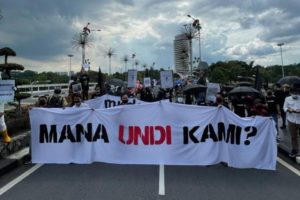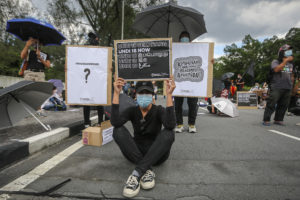Recently, I have been observing the increasing youth engagement efforts in civic and political spaces. It is either through formal institutional mechanisms or youth creating their own spaces to champion the causes they believe in and affecting change. While youths worldwide continue to take and claim their spaces in the public sphere, there are institutions providing various platforms and programmes to further develop youth leadership. Two common arguments within youth spaces exist. The first suggests that these institutional opportunities serve as mere tokenistic media exercises and lip service. The second argues that mechanisms established by institutions are effective in including youths in decision-making processes and providing resources for youths. Recognising these two common arguments, in this article I illustrate that for meaningful youth participation, youth spaces must be accessible, inclusive and serving as a space to build connections.
The United Nations launched the Youth2030: The United Nations Youth Strategy in 2018 at a High-Level in New York. This strategy does not negate the various youth engagement mechanisms that were established before the launch. Nonetheless, it sends a strong signal that youths are important stakeholders for increased impact especially in the “engagement and participation in the implementation, review, and follow-up of the 2030 Agenda for Sustainable Development” including other relevant global agendas.
Furthermore, Youth2030 aims to build the agency of young people and advance their rights through global, regional, and country-level actions. This is particularly momentous as there are opportunities for youth engagement while we are going through COVID-19 waves of recovery and spikes of cases with newer strains. For more than a year now since its first recorded case, COVID-19 has highlighted key areas deeply affecting youths. Some of these areas are education, employment, and governance that highlight intergenerational inequity, lack of accountability, and injustice.

The Star/Asia News Network (Straits Times): Protestors holding the banner which reads “Where’s our votes?” in front of the Parliament building, Kuala Lumpur, Malaysia
Particularly in Southeast Asia, there are increasing movements and protests mobilised and led by youths. This is due to the issues with governance and the lack of initiated intentional engagements. In Thailand, youths are protesting against the authoritative government i.e. the monarchy. Similar to Myanmar, young people–as young as 15 years old–are at the frontline protesting against the military junta’s coup. In Indonesia youths are mobilised to protest the Omnibus Law as neither the President nor the People’s Representative Council “consult or compromise with the people and continued to push the ratification of the bill”. More recently, Malaysian youths are protesting against the delay in implementing voters’ registration for 18-year-olds in the country, and the suspension of Parliamentary sittings due to COVID-19. The Election Committees are delaying the implementation of the 2019 “Undi18 Bill” affect 1.2 million youths between the age of 19 to 20 in Malaysia. These occurrences suggest that the government are disregarding youth’s and the opposition’s voices by preventing access from the established platforms. Thus, youths are protesting as a way to engage with their government.

Yusof Mat Isa (Malay Mail): Protestors and their placards protesting on the delay of the Undi18 Bill in front of the Parliament building, Kuala Lumpur, Malaysia
While there are rising youth-led movements and protests, there are multilateral platforms available for youth to partake in various initiatives and contribute towards causes passionately. As we are gathered here in the 4th ASEFYLS, I had the pleasure to discuss the factors and challenges of meaningful youth participation in the context of Asia and Europe with two participants. They are Tiago Gonçalves from Portugal, and Visal Chourn from Cambodia.
Both Gonçalves and Chourn agree that honesty and trust are important to a mutually beneficial relationship. It will also foster a relationship that is based on respect, love, and dignity. This will produce a transparent process that helps in working together for the implementation of respective projects. They further explain that both honesty and trust require commitment from group members. Gonçalves suggests that commitment would allow for one to know one’s own limitations and strength, and further expresses, “we should know how to ask for help and we should be available to provide help to the ones who need it”. Chourn explains that trust among members is built through time and commitment “to be able to open up about certain vulnerabilities that are deeply in their hearts”. The structure of ASEFYLS where it is set for 10 months with three phases definitively establishes the space for the opportunity to foster honesty and trust among members, facilitators, and organisers.
Besides honesty and trust, Gonçalves points to the importance of cultural knowledge and intercultural intelligence for meaningful engagement. The current rate of transboundary cooperation and collaboration presents several challenges as there are different cultures, life experiences, and biases. This is particularly prevalent in the context of Asia and Europe, but the difference in cultures should not be the reason for people to work in isolation. To Gonçalves, people need to learn from each other through conversations and “see how can we adapt our behaviour in a way that we can be sure we are respecting each other”. Cultural awareness assures Gonçalves to interact with others where it is an opportunity to exchange cultural knowledge and gain friendships.
Chourn expressed that one of the biggest challenges of COVID-19 is the adaptation of the program to online platforms. This adaptation of an immersive program presents a barrier to engagement where the up close and personal approaches are lacking. In this case, “participants bear the responsibility to be present, showing up to discussions and be interactive, whereas the organisers must ensure that the spaces provided are accessible”, asserts Chourn. He further adds that youths must be guided by mentors. As he reflects on his ‘Leadership in Action’ project: Food Forest, Chourn believes that this is a vital aspect for successful learning where there are mentors who are willing to listen, understand, and encourage their mentees.
Both Chourn and Gonçalves shares their sentiment on the importance of empathy. Chourn affirms that youth must be able to relate their emotions with the current trends so that they can relate their feelings and thinking. According to him, this is a way to develop empathy so that each party can play their respective roles. Gonçalves sees the importance to put himself in others’ positions or contexts, which helps him to understand their motivations or struggles. The understanding of each other’s motivations contexts and problems are key for solidarity, he feels. In the case of ASEFYLS, he assumes that “we all want the same: to leave a better legacy for the next generations”.
Listening to Chourn and Gonçalves, I choose to remain hopeful. At this point, we are at a pivotal crossroads for meaningful change. I believe that we, the youth, are readily dedicated to making the necessary changes for sustainable development beyond Agenda 2030.



